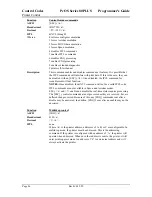
Control Codes
PcOS Series 80PLUS
Programmer's Guide
Bar Codes
Page 42
Rev B 4/13/99
Bar codes
The PcOS Series 80PLUS Printer supports the ability to print bar codes. The printer will print one of
five formats, Interleaved 2 of 5, Code 39, Code 128, UPC A, or EAN-13. The host does not need to
form the graphic image for these bar codes. The host need only send the printer the information to be
bar coded, and a graphic will be generated. Bar codes can be printed in a high-resolution “normal”
mode or a “fast” high-speed mode. The normal mode is more readable than the high-speed mode.
(See the [ESC][EM]B command on the next page for setting the bar code height and print speed.)
Function
Print bar code
ASCII
[ESC] b <n>{information}[ETX]
Hexadecimal
1BH 62H <n>... 03H
Decimal
<27><98><n> ... <3>
IPCL
&%25 ... [CR]
Interleaved 2 of 5
&%39 ... [CR]
Code 39
&%12 ... [CR]
Code 128
&%UP ... [CR] UPC A
&%UE ... [CR] UPC E
&%EA ... [CR] EAN-13
&%E8 ... [CR] EAN-8
Description
This command prints the information as a bar code. The bar code will be
centered on the print zone.
Where n
0
Interleaved 2 of 5
Numeric (0-9) only; must be even number of
digits
1
Code 39
26 uppercase letters (A-Z); 10 digits (0-9)
2
Code 128
Three sets of 106 different characters
3
UPC A
Numeric (0-9) only; 11 digits
4
EAN-13
Numeric (0-9) only; 12 digits
5
UPC E
Numeric (0-9) only; 11 digits
6
EAN-8
Numeric (0-9) only; 6 digits
Interleaved 2 of 5
This is a high-density, self-checking, continuous, numeric bar code. It is
mainly used where fixed length numeric fields are required. The data field
must be an even number of characters. If an odd data field is sent to the
PcOS Series 80PLUS Printer, it will be zero padded. Due to space
limitations, only 20 characters can be printed.
NOTE:
Interleaved 2 of 5 does not read well in “fast” mode.
Code 39
This is an alphanumeric bar code. It is a discrete, self-checking, variable-
length code. The complete data field is printed. Due to space limitations,
only 10 characters can be printed. If illegal characters are passed to the
printer, they are converted to legal codes. For example, a
→
A.
Code 128
This is an alphanumeric bar code. It is a high density, variable length,
continuous code that employs multiple element widths. Code 128 has three
possible start codes. The start code defines the code set: A, B, or C. The
first character in the data field defines the Code Set. Start Code A =
<135>; Code B = <136>; and Code C = <137>. The complete data field is
printed. Due to space limitations, only ten characters can be printed. The
printer generates a check digit.
Code 128 Note
With Code 128, the ‘A’ space is defined as a <0>. This makes
programming difficult and causes control character conflicts for the
printer. To help solve these problems in Code 128, the PcOS Series
80PLUS Printer subtracts 32 from all characters that are to be included in
the bar code. In the Code 128 definition, an ‘A’ is <33>. However, the
















































